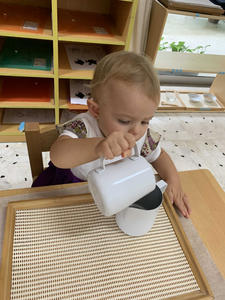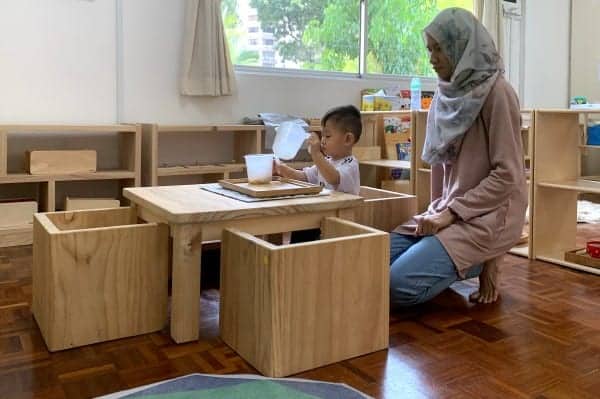A huge part of a child’s early development is learning to control their movements. There is a progression that each infant and child goes through as they learn to control each muscle from their mouth and tongue down to their toes. As a physician, Dr. Maria Montessori saw the link between a child’s physical development and their psycho-social development; she had children trace sandpaper letters to facilitate the link between muscle and memory, a practice that continues today. There is a lot to say about motor skills, so much in fact that this is just the first of a series on the subject by House on the Hill! This month we’re talking about fine motor skills and how Montessori practice– everything from the environment to the teacher’s behavior– help grow and refine these fine movements.
When we talk about movement there are two big categories: fine motor and gross motor. Gross motor skills are the big movements, like crawling and hopping. Fine motor skills are small movements of the hands, fingers and arms that use hand-eye coordination, dexterity and control. For infants, fine motor skills include sucking on their hands and later passing objects from one hand to another. For older children, fine motor skills include writing with a pencil or using scissors. As with any skill, fine motor skills take practice and build on previous mastery.

Fine motor skills are essential. They help children master their environment and operate independently in their world, building up their confidence and self-esteem at the same time. Extensive studies performed over the years have concluded that fine motor skills are significantly linked to later performance in literacy and mathematics at school.
Developing fine motor skills is not that straight forward, however. The environment, the materials, and the encouragement and guidance of care-givers must all come together with the child’s physical development. At House on the Hill we start fine motor skill work starts at an early age, in our Nido, and continue to grow with the child as they grow and develop.
Take a look at this video of an infant in our Nido pouring a glass of water. That is a lot of fine motor work! If we break it down we can see the steps involved in developing fine motor skills.
Follow the child: children’s development has a sequence we can’t rush. We can’t run before we walk, and we can’t pour before we can grip. In infancy we encourage reaching and holding everything from balls to milk bottles, developing a child’s grip and hand-eye coordination. Activities such as clay play, stacking blocks and threading hone that hand eye coordination.

Imitation is learning: children learn many things from observing adults in their day to day life, but sometimes we need to break it down just for them. We do a step by step, slow demonstration of the pouring process. Curious young eyes like to concentrate on the moving water, but they are also absorbing the sequence of movements.
Curiosity to conquest: the child must do, and re-do, the activity to learn. We set up a safe and supportive environment for them to pour, miss, sip, spill and keep on trying.
Maybe tomorrow: if the child isn’t interested in the activity they may not be ready yet, or it may just not be their day. That is ok! We pack up and try again another day; consistency is key.
Pouring on the support for fine motor skill development:

1. Help them help themselves by setting up the right space. For pouring we prepare a pitcher and a glass that are sized right for their hands, a tray to keep things tidy, and an apron and sponge for catching spills.
2. Let them help themselves by resisting the urge to step in. We demonstrate once or twice, and then let them work uninterrupted and repetitively.
3. It is not about perfection. As much as this first attempt at pouring requires foundational skills, it is also an opportunity to further develop those skills and they will progress with time.
4. It is not about praise. With time children find intrinsic joy in independent work. We avoid praising the child to prevent them from doing the activity only for our acknowledgment.

Pouring is just one example of fine motor skill work in the Montessori classroom. Check out this chart to see all the ways that Montessori materials are designed for age-appropriate gross and fine motor skill development! But no matter the age or ability, the Montessori method provides clear steps, excellent materials, and guidance in encouraging fine motor skill development.
Meet our team, tour our campus and understand the benefits of starting Montessori early!









